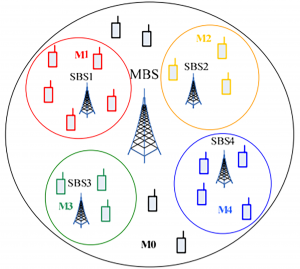Performance analysis of Heterogeneous Cellular Caching Networks
The growing concern about various types of contents along with the developments in terms of network traffic has led to significant challenges for cellular networks. As an approach to figure out the mentioned issues Lately, network caching has been proposed to overcome the mentioned issues. Concisely, a cellular network is a communication network distributed over land through cells where each cell includes a fixed location transceiver known as a base station. Basically, a heterogeneous cellular network consists of a single macrocell in which N small cell base stations (SBSs) cooperate with the macrocell base station (MBS).
Dr. Fatemeh Rezaei, Assistant Professor at Computer Engineering Department, K. N. Toosi University of Technology in collaboration with Prof. Babak Khalaj, Professor at Electrical Engineering Department, the Sharif University of Technology as well as Dr. Ming Xiao and Prof. Mikael Skoglund, Communication Theory Department, KTH, Stockholm, Sweden; have published an article about Caching in Heterogeneous Cellular Networks which published in the 23rd International Conference on Telecommunications (ICT).
“We propose a general delay and stability performance analysis in Heterogeneous Cellular Caching Networks (HCCNs), based on queuing theory. Moreover, we’ve suggested new performance metrics in HCCNs and offered an optimization problem which minimizes the average experienced delay for users by ensuring the stability of the network,” said Dr. Rezaei.
In a simple definition, Queueing theory is the mathematical study of waiting for lines or queues which makes us able to predict the waiting time and the length of the queue. In this case, Dr.Rezaei and her colleagues have provided a queueing model for the studied network and derived the performance metrics.
Previously, in one of Dr. Rezaei’s articles, the effect of various caching replacement policies such as Least Recently Used (LRU), Least Frequently Used (LFU), and random (RAND), on the network performance has been investigated. Based on the results, LFU has shown the best performance among the aforementioned cache replacement policies hence, the equation of the average delay for LFU is used for future steps.

As a matter of fact, the more a system becomes unstable, the more infinite the average response delay we have. Therefore, they defined a variable as the minimum stabilizer cache size for each SBS, so they first obtained the value of minimum stabilizer cache size for each SBS, as the minimum cache size for having a stable system. Then they were able to derive an equation to the minimum acceptable cache size to have an acceptable delay. In contrast with previous articles where the NP-hard model was obtained, they came up with a less complicated model.
In the next step, they evaluated the derived equations through real trace-driven experiments on traffic of YouTube video requests. accordingly, they have compared the real trace results with the derived equations for IRM traffic. As a result of that, it was observed that by increasing the requests throughputs, the value of minimum stabilizer cache size for each SBS increases. Moreover, the effect of the MBS utilization factor on the average response delay is much more than that of the SBSs. Finally, they illustrated that increasing the cache size more than some values does not change the average response delay significantly.
In conclusion, Dr.Rezaei and her colleagues have indicated a delay and stability analysis in HCCNs. Furthermore, they have provided insight regarding the delay behavior in HCCNs and the design of such networks in order to have tolerable delays.
Co-authors are Prof. Babak Khalaj, a Professor of the Electrical Engineering Department at the Sharif University of Technology, Tehran, Iran, Dr. Ming Xiao, and Prof. Mikael Skoglund, Communication Theory Department, KTH, Stockholm, Sweden.
For more details, you can use the Delay and Stability Analysis of Caching in Heterogeneous Cellular Networks article published in the 23rd International Conference on Telecommunications (ICT).





